Zhixuan Liang
Expertise need not monopolize: Action-Specialized Mixture of Experts for Vision-Language-Action Learning
Oct 16, 2025Abstract:Vision-Language-Action (VLA) models are experiencing rapid development and demonstrating promising capabilities in robotic manipulation tasks. However, scaling up VLA models presents several critical challenges: (1) Training new VLA models from scratch demands substantial computational resources and extensive datasets. Given the current scarcity of robot data, it becomes particularly valuable to fully leverage well-pretrained VLA model weights during the scaling process. (2) Real-time control requires carefully balancing model capacity with computational efficiency. To address these challenges, We propose AdaMoE, a Mixture-of-Experts (MoE) architecture that inherits pretrained weights from dense VLA models, and scales up the action expert by substituting the feedforward layers into sparsely activated MoE layers. AdaMoE employs a decoupling technique that decouples expert selection from expert weighting through an independent scale adapter working alongside the traditional router. This enables experts to be selected based on task relevance while contributing with independently controlled weights, allowing collaborative expert utilization rather than winner-takes-all dynamics. Our approach demonstrates that expertise need not monopolize. Instead, through collaborative expert utilization, we can achieve superior performance while maintaining computational efficiency. AdaMoE consistently outperforms the baseline model across key benchmarks, delivering performance gains of 1.8% on LIBERO and 9.3% on RoboTwin. Most importantly, a substantial 21.5% improvement in real-world experiments validates its practical effectiveness for robotic manipulation tasks.
Discrete Diffusion VLA: Bringing Discrete Diffusion to Action Decoding in Vision-Language-Action Policies
Aug 27, 2025Abstract:Vision-Language-Action (VLA) models adapt large vision-language backbones to map images and instructions to robot actions. However, prevailing VLA decoders either generate actions autoregressively in a fixed left-to-right order or attach continuous diffusion or flow matching heads outside the backbone, demanding specialized training and iterative sampling that hinder a unified, scalable architecture. We present Discrete Diffusion VLA, a single-transformer policy that models discretized action chunks with discrete diffusion and is trained with the same cross-entropy objective as the VLM backbone. The design retains diffusion's progressive refinement paradigm while remaining natively compatible with the discrete token interface of VLMs. Our method achieves an adaptive decoding order that resolves easy action elements before harder ones and uses secondary remasking to revisit uncertain predictions across refinement rounds, which improves consistency and enables robust error correction. This unified decoder preserves pretrained vision language priors, supports parallel decoding, breaks the autoregressive bottleneck, and reduces the number of function evaluations. Discrete Diffusion VLA achieves 96.3% avg. SR on LIBERO, 71.2% visual matching on SimplerEnv Fractal and 49.3% overall on SimplerEnv Bridge, improving over both autoregressive and continuous diffusion baselines. These findings indicate that discrete-diffusion action decoder supports precise action modeling and consistent training, laying groundwork for scaling VLA to larger models and datasets.
DexHandDiff: Interaction-aware Diffusion Planning for Adaptive Dexterous Manipulation
Dec 11, 2024



Abstract:Dexterous manipulation with contact-rich interactions is crucial for advanced robotics. While recent diffusion-based planning approaches show promise for simpler manipulation tasks, they often produce unrealistic ghost states (e.g., the object automatically moves without hand contact) or lack adaptability when handling complex sequential interactions. In this work, we introduce DexHandDiff, an interaction-aware diffusion planning framework for adaptive dexterous manipulation. DexHandDiff models joint state-action dynamics through a dual-phase diffusion process which consists of pre-interaction contact alignment and post-contact goal-directed control, enabling goal-adaptive generalizable dexterous manipulation. Additionally, we incorporate dynamics model-based dual guidance and leverage large language models for automated guidance function generation, enhancing generalizability for physical interactions and facilitating diverse goal adaptation through language cues. Experiments on physical interaction tasks such as door opening, pen and block re-orientation, and hammer striking demonstrate DexHandDiff's effectiveness on goals outside training distributions, achieving over twice the average success rate (59.2% vs. 29.5%) compared to existing methods. Our framework achieves 70.0% success on 30-degree door opening, 40.0% and 36.7% on pen and block half-side re-orientation respectively, and 46.7% on hammer nail half drive, highlighting its robustness and flexibility in contact-rich manipulation.
DexDiffuser: Interaction-aware Diffusion Planning for Adaptive Dexterous Manipulation
Nov 27, 2024



Abstract:Dexterous manipulation with contact-rich interactions is crucial for advanced robotics. While recent diffusion-based planning approaches show promise for simpler manipulation tasks, they often produce unrealistic ghost states (e.g., the object automatically moves without hand contact) or lack adaptability when handling complex sequential interactions. In this work, we introduce DexDiffuser, an interaction-aware diffusion planning framework for adaptive dexterous manipulation. DexDiffuser models joint state-action dynamics through a dual-phase diffusion process which consists of pre-interaction contact alignment and post-contact goal-directed control, enabling goal-adaptive generalizable dexterous manipulation. Additionally, we incorporate dynamics model-based dual guidance and leverage large language models for automated guidance function generation, enhancing generalizability for physical interactions and facilitating diverse goal adaptation through language cues. Experiments on physical interaction tasks such as door opening, pen and block re-orientation, and hammer striking demonstrate DexDiffuser's effectiveness on goals outside training distributions, achieving over twice the average success rate (59.2% vs. 29.5%) compared to existing methods. Our framework achieves 70.0% success on 30-degree door opening, 40.0% and 36.7% on pen and block half-side re-orientation respectively, and 46.7% on hammer nail half drive, highlighting its robustness and flexibility in contact-rich manipulation.
G3Flow: Generative 3D Semantic Flow for Pose-aware and Generalizable Object Manipulation
Nov 27, 2024



Abstract:Recent advances in imitation learning for 3D robotic manipulation have shown promising results with diffusion-based policies. However, achieving human-level dexterity requires seamless integration of geometric precision and semantic understanding. We present G3Flow, a novel framework that constructs real-time semantic flow, a dynamic, object-centric 3D semantic representation by leveraging foundation models. Our approach uniquely combines 3D generative models for digital twin creation, vision foundation models for semantic feature extraction, and robust pose tracking for continuous semantic flow updates. This integration enables complete semantic understanding even under occlusions while eliminating manual annotation requirements. By incorporating semantic flow into diffusion policies, we demonstrate significant improvements in both terminal-constrained manipulation and cross-object generalization. Extensive experiments across five simulation tasks show that G3Flow consistently outperforms existing approaches, achieving up to 68.3% and 50.1% average success rates on terminal-constrained manipulation and cross-object generalization tasks respectively. Our results demonstrate the effectiveness of G3Flow in enhancing real-time dynamic semantic feature understanding for robotic manipulation policies.
Plot2Code: A Comprehensive Benchmark for Evaluating Multi-modal Large Language Models in Code Generation from Scientific Plots
May 13, 2024



Abstract:The remarkable progress of Multi-modal Large Language Models (MLLMs) has attracted significant attention due to their superior performance in visual contexts. However, their capabilities in turning visual figure to executable code, have not been evaluated thoroughly. To address this, we introduce Plot2Code, a comprehensive visual coding benchmark designed for a fair and in-depth assessment of MLLMs. We carefully collect 132 manually selected high-quality matplotlib plots across six plot types from publicly available matplotlib galleries. For each plot, we carefully offer its source code, and an descriptive instruction summarized by GPT-4. This approach enables Plot2Code to extensively evaluate MLLMs' code capabilities across various input modalities. Furthermore, we propose three automatic evaluation metrics, including code pass rate, text-match ratio, and GPT-4V overall rating, for a fine-grained assessment of the output code and rendered images. Instead of simply judging pass or fail, we employ GPT-4V to make an overall judgement between the generated and reference images, which has been shown to be consistent with human evaluation. The evaluation results, which include analyses of 14 MLLMs such as the proprietary GPT-4V, Gemini-Pro, and the open-sourced Mini-Gemini, highlight the substantial challenges presented by Plot2Code. With Plot2Code, we reveal that most existing MLLMs struggle with visual coding for text-dense plots, heavily relying on textual instruction. We hope that the evaluation results from Plot2Code on visual coding will guide the future development of MLLMs. All data involved with Plot2Code are available at https://huggingface.co/datasets/TencentARC/Plot2Code.
Digital Twin-assisted Reinforcement Learning for Resource-aware Microservice Offloading in Edge Computing
Mar 13, 2024



Abstract:Collaborative edge computing (CEC) has emerged as a promising paradigm, enabling edge nodes to collaborate and execute microservices from end devices. Microservice offloading, a fundamentally important problem, decides when and where microservices are executed upon the arrival of services. However, the dynamic nature of the real-world CEC environment often leads to inefficient microservice offloading strategies, resulting in underutilized resources and network congestion. To address this challenge, we formulate an online joint microservice offloading and bandwidth allocation problem, JMOBA, to minimize the average completion time of services. In this paper, we introduce a novel microservice offloading algorithm, DTDRLMO, which leverages deep reinforcement learning (DRL) and digital twin technology. Specifically, we employ digital twin techniques to predict and adapt to changing edge node loads and network conditions of CEC in real-time. Furthermore, this approach enables the generation of an efficient offloading plan, selecting the most suitable edge node for each microservice. Simulation results on real-world and synthetic datasets demonstrate that DTDRLMO outperforms heuristic and learning-based methods in average service completion time.
* 9 pages, 5 figures
RoboCodeX: Multimodal Code Generation for Robotic Behavior Synthesis
Feb 25, 2024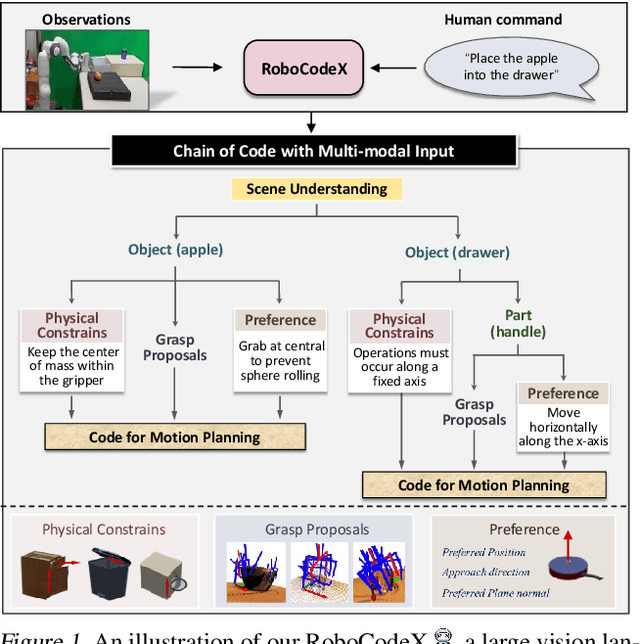

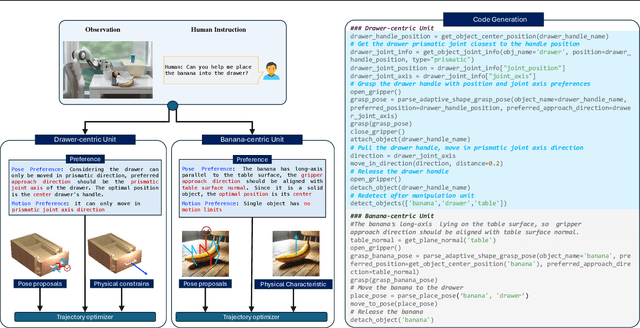

Abstract:Robotic behavior synthesis, the problem of understanding multimodal inputs and generating precise physical control for robots, is an important part of Embodied AI. Despite successes in applying multimodal large language models for high-level understanding, it remains challenging to translate these conceptual understandings into detailed robotic actions while achieving generalization across various scenarios. In this paper, we propose a tree-structured multimodal code generation framework for generalized robotic behavior synthesis, termed RoboCodeX. RoboCodeX decomposes high-level human instructions into multiple object-centric manipulation units consisting of physical preferences such as affordance and safety constraints, and applies code generation to introduce generalization ability across various robotics platforms. To further enhance the capability to map conceptual and perceptual understanding into control commands, a specialized multimodal reasoning dataset is collected for pre-training and an iterative self-updating methodology is introduced for supervised fine-tuning. Extensive experiments demonstrate that RoboCodeX achieves state-of-the-art performance in both simulators and real robots on four different kinds of manipulation tasks and one navigation task.
RoboScript: Code Generation for Free-Form Manipulation Tasks across Real and Simulation
Feb 22, 2024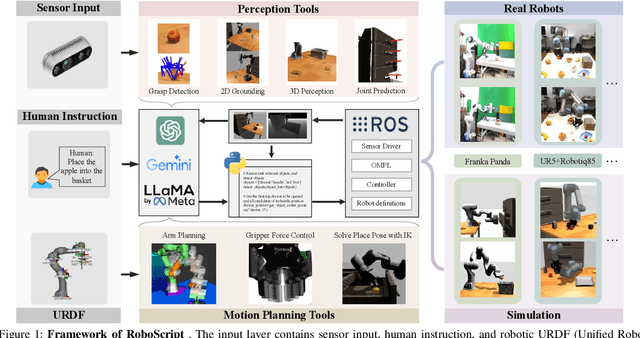
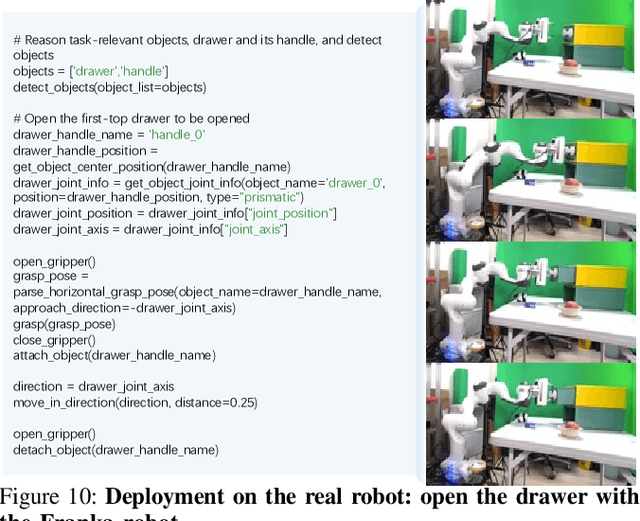
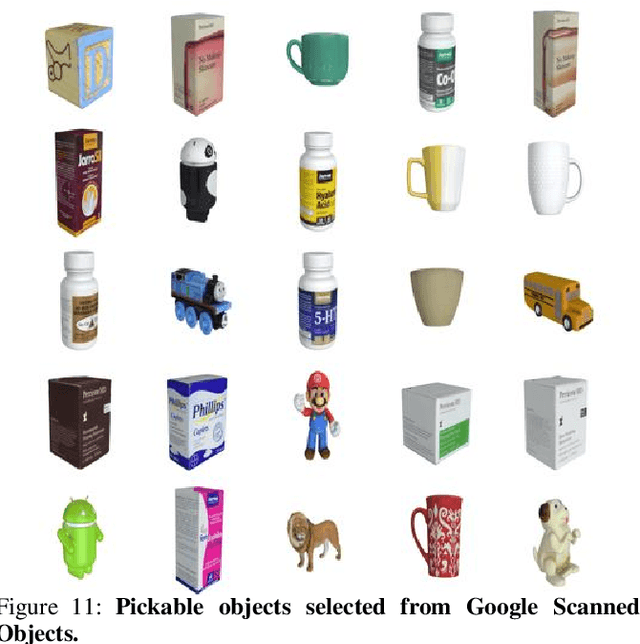
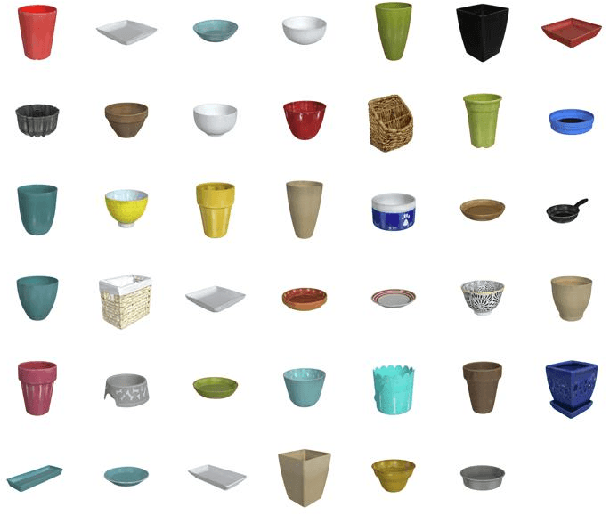
Abstract:Rapid progress in high-level task planning and code generation for open-world robot manipulation has been witnessed in Embodied AI. However, previous studies put much effort into general common sense reasoning and task planning capabilities of large-scale language or multi-modal models, relatively little effort on ensuring the deployability of generated code on real robots, and other fundamental components of autonomous robot systems including robot perception, motion planning, and control. To bridge this ``ideal-to-real'' gap, this paper presents \textbf{RobotScript}, a platform for 1) a deployable robot manipulation pipeline powered by code generation; and 2) a code generation benchmark for robot manipulation tasks in free-form natural language. The RobotScript platform addresses this gap by emphasizing the unified interface with both simulation and real robots, based on abstraction from the Robot Operating System (ROS), ensuring syntax compliance and simulation validation with Gazebo. We demonstrate the adaptability of our code generation framework across multiple robot embodiments, including the Franka and UR5 robot arms, and multiple grippers. Additionally, our benchmark assesses reasoning abilities for physical space and constraints, highlighting the differences between GPT-3.5, GPT-4, and Gemini in handling complex physical interactions. Finally, we present a thorough evaluation on the whole system, exploring how each module in the pipeline: code generation, perception, motion planning, and even object geometric properties, impact the overall performance of the system.
SkillDiffuser: Interpretable Hierarchical Planning via Skill Abstractions in Diffusion-Based Task Execution
Dec 18, 2023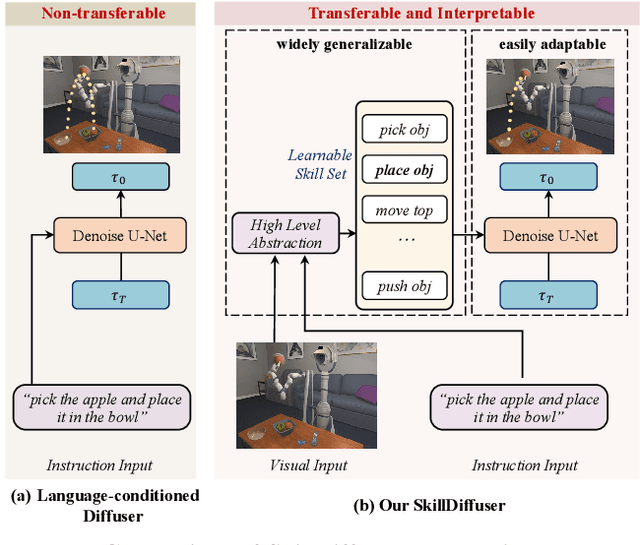

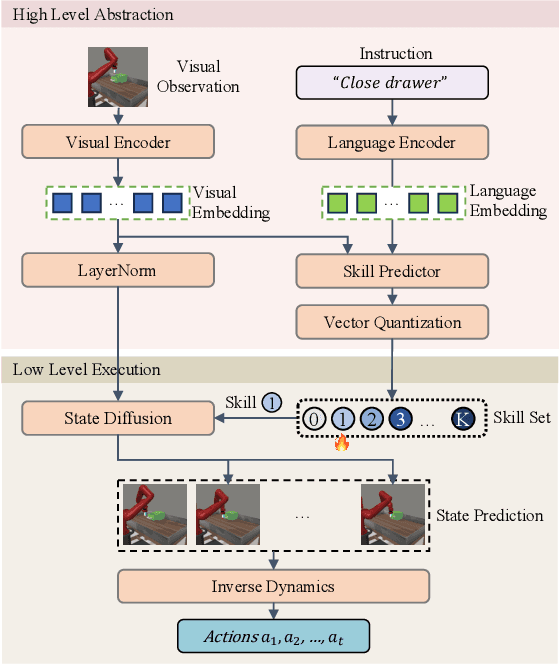
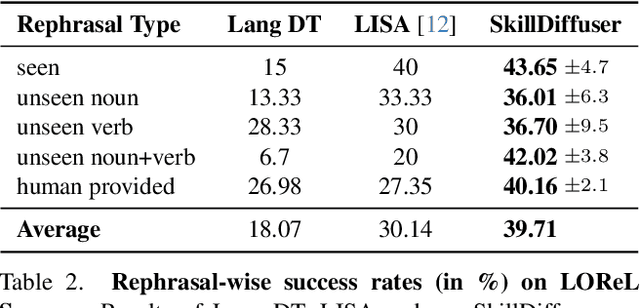
Abstract:Diffusion models have demonstrated strong potential for robotic trajectory planning. However, generating coherent and long-horizon trajectories from high-level instructions remains challenging, especially for complex tasks requiring multiple sequential skills. We propose SkillDiffuser, an end-to-end hierarchical planning framework integrating interpretable skill learning with conditional diffusion planning to address this problem. At the higher level, the skill abstraction module learns discrete, human-understandable skill representations from visual observations and language instructions. These learned skill embeddings are then used to condition the diffusion model to generate customized latent trajectories aligned with the skills. It allows for generating diverse state trajectories that adhere to the learnable skills. By integrating skill learning with conditional trajectory generation, SkillDiffuser produces coherent behavior following abstract instructions across diverse tasks. Experiments on multi-task robotic manipulation benchmarks like Meta-World and LOReL demonstrate state-of-the-art performance and human-interpretable skill representations from SkillDiffuser.
 Add to Chrome
Add to Chrome Add to Firefox
Add to Firefox Add to Edge
Add to Edge